By Rebecca Nall
In 2008, Baylor University’s Mayborn Museum Complex introduced a Free Sunday program that offered free admission on the first Sunday of every month, with the goal of reaching under-served audiences in the community. The success of Free Sundays continued to grow, in fact, last year the average attendance was around 1300 people. When you consider that this is during a four-hour period and the average visitation on other Sundays is 250, you begin to see the impact of this program.
Over the last several years, the museum began tracking the zip codes of attendees on Free Sundays to determine if we were reaching our target audience. Only 20% of our visitation on those days were from zip codes 76704, 76706, and 76707, which have the highest percentage of residents living under the poverty level. Considering this and the fact that Sunday might not be an ideal day for everyone to visit the museum, we started to wonder if we were doing our best to reach the audiences who need us most.
This fall, we said goodbye to our Free Sunday program and launched Mayborn Reach Out to reach new and under-served audiences. We believe this evolution will allow us to better serve our local community. Through more strategic advertising, we plan to work harder to get the word out to low-income families. Mayborn Reach Out also allows people to visit the museum at their convenience, not just one day a month.
Mayborn Reach Out encompasses three new programs that provide visitors of all means access to the resources within the museum: Community Days, Borrow a Membership, and participation in Museums For All.
Community Days
Visitors can explore the Discovery Center, natural and cultural history exhibits, and the Gov. Bill & Vara Daniel Historic Village at no admission cost.
- Monday, January 15, 2018
- Wednesday, May 19, 2018
- Saturday, September 24, 2018
Borrow a Membership
The Mayborn Museum has partnered with the Waco/McLennan County and Hewitt Public Libraries to offer library patrons the opportunity to borrow a museum membership at no cost. Interested families or individuals may visit their nearest branch to check out a pass for free admission to the museum.
Museums for All
The Museums for All program provides discounted museum admission for visitors that receive public assistance. It is a signature access program of the Association of Children’s Museums (ACM) and the Institute of Museum and Library Services (IMLS) to encourage families of all backgrounds to visit museums regularly and build lifelong museum habits. Effective October 1, the program enables low-income families to visit the Mayborn Museum Complex for a minimal fee. For $1 each, two adults and all children in the household are admitted with the presentation of an Electronic Benefits Transfer (EBT) card. EBT card holders are also eligible for a discounted membership of $10.
It is thanks to our loyal constituents, members, and friends that we are able to offer access programs like this. Thanks for helping us build a stronger community! Museums like ours are often the spark that encourages lifelong learning, and we believe that everyone has a right to access this informal extension to traditional classroom education.
 Rebecca Tucker Nall is the Assistant Director of Exhibits, Communication, and Visitor Services at the Mayborn Museum Complex. She is a museum enthusiast, an avid reader, and a mother to two small, yet fierce girls.
Rebecca Tucker Nall is the Assistant Director of Exhibits, Communication, and Visitor Services at the Mayborn Museum Complex. She is a museum enthusiast, an avid reader, and a mother to two small, yet fierce girls.
By Jeanne Dittman
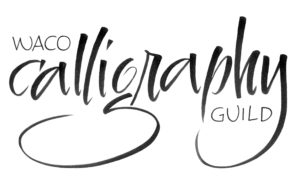 Have you ever stopped in a store to appreciate a handlettered sign simply for its beautiful artistry and not just for what it was selling? Do the shapes of letterforms intrigue and delight you? Do you have a favorite pen that you must use for certain special occasions? Then the Waco Calligraphy Guild may be your kind of people.
Have you ever stopped in a store to appreciate a handlettered sign simply for its beautiful artistry and not just for what it was selling? Do the shapes of letterforms intrigue and delight you? Do you have a favorite pen that you must use for certain special occasions? Then the Waco Calligraphy Guild may be your kind of people.
Founded in 1988, the Waco Calligraphy Guild is a group of creative people united by our love of letters. Some of us hang our shingles out as professional calligraphers, whereas some would just rather write and doodle on old shingles (or paper). Some of us have mastered many different lettering styles over the years – from classical Roman capitals to contemporary pointed pen script – whereas some have just picked up a calligraphy pen for the first time in recent months. Some of us teach calligraphy, some of us attend calligraphy workshops and conferences, and all of us are lifelong students of the lettering arts.
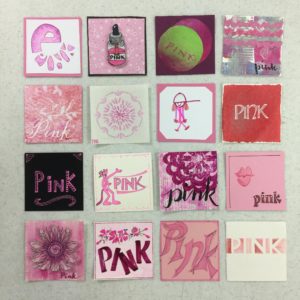 The guild currently has a membership of around 40 people, and we gather on the second Saturday of each month at 10am at St. Matthew Lutheran Church (800 North New Road in Waco). We always serve snacks, since some of us are excellent bakers and some of us are excellent buyers of baked goods. We begin with a short business meeting, share our 3×3 artwork response to a monthly prompt (a small “canvas” that can be chock-filled with inspiration), break for some conversation and treats, and then proceed with our educational program. This hour-long program is usually led by one of our members, and most often is a hands-on lesson in something pertaining to the lettering arts. We are sometimes writing a new lettering style or using a new tool. We are sometimes learning a new book or card technique on which our lettering can be placed. And, we are sometimes introduced to an entirely new art form to which letters may be added later. No matter the topic, we leave inspired for having done something creative with a room full of creative people.
The guild currently has a membership of around 40 people, and we gather on the second Saturday of each month at 10am at St. Matthew Lutheran Church (800 North New Road in Waco). We always serve snacks, since some of us are excellent bakers and some of us are excellent buyers of baked goods. We begin with a short business meeting, share our 3×3 artwork response to a monthly prompt (a small “canvas” that can be chock-filled with inspiration), break for some conversation and treats, and then proceed with our educational program. This hour-long program is usually led by one of our members, and most often is a hands-on lesson in something pertaining to the lettering arts. We are sometimes writing a new lettering style or using a new tool. We are sometimes learning a new book or card technique on which our lettering can be placed. And, we are sometimes introduced to an entirely new art form to which letters may be added later. No matter the topic, we leave inspired for having done something creative with a room full of creative people.
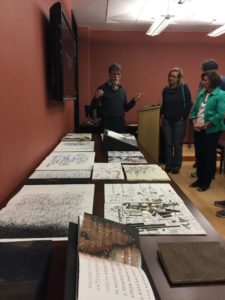 The calligraphic arts trace their roots to the medieval scribes who labored over their parchment and quills creating the exquisite manuscripts that now lie in museums and continue to inspire artists worldwide. Their techniques with broad-edged pens and inks have been studied through the centuries, and many of our lettering styles (and typefaces and computer fonts) are based on the elegant combinations of strokes that they first created. Even as technologies have changed the book arts – first the printing press and ultimately the computer – the elegance of hand-lettered artwork still holds a special place in the artistic world. Calligraphers have served queens and presidents through the years, as well as institutions conferring degrees and brides mailing wedding invitations. In recent years, the newest visual technologies of Instagram and Pinterest have sparked a renewed interest in the lettering arts. Pointed pen and pointed brush calligraphy have taken on a contemporary feel that can be widely seen in advertisements, home furnishings, and even the offerings of Magnolia Market.
The calligraphic arts trace their roots to the medieval scribes who labored over their parchment and quills creating the exquisite manuscripts that now lie in museums and continue to inspire artists worldwide. Their techniques with broad-edged pens and inks have been studied through the centuries, and many of our lettering styles (and typefaces and computer fonts) are based on the elegant combinations of strokes that they first created. Even as technologies have changed the book arts – first the printing press and ultimately the computer – the elegance of hand-lettered artwork still holds a special place in the artistic world. Calligraphers have served queens and presidents through the years, as well as institutions conferring degrees and brides mailing wedding invitations. In recent years, the newest visual technologies of Instagram and Pinterest have sparked a renewed interest in the lettering arts. Pointed pen and pointed brush calligraphy have taken on a contemporary feel that can be widely seen in advertisements, home furnishings, and even the offerings of Magnolia Market.
 If any part of this expansive history of lettering intrigues you, you are not alone. We invite you to visit the Waco Calligraphy Guild and find your people already gathered. You can see what we are up to each month by viewing our colorful newsletters and other goodies on our website. We have participated in the Waco Cultural Arts Fest for years – perhaps you have stopped by our booth at the end of the Suspension Bridge and had your name lettered by us on one of our giveaways. We also produce a full-color calendar each year with original artwork by 12 (or more) of our members – they are $10 each and available for a limited time through a guild member. Feel free to visit a guild meeting on us – membership is only $25 a year, but you don’t need to be a member to attend the first time. And please never let a lack of supplies prevent you from attending a program – we always have plenty to share. (calendar)
If any part of this expansive history of lettering intrigues you, you are not alone. We invite you to visit the Waco Calligraphy Guild and find your people already gathered. You can see what we are up to each month by viewing our colorful newsletters and other goodies on our website. We have participated in the Waco Cultural Arts Fest for years – perhaps you have stopped by our booth at the end of the Suspension Bridge and had your name lettered by us on one of our giveaways. We also produce a full-color calendar each year with original artwork by 12 (or more) of our members – they are $10 each and available for a limited time through a guild member. Feel free to visit a guild meeting on us – membership is only $25 a year, but you don’t need to be a member to attend the first time. And please never let a lack of supplies prevent you from attending a program – we always have plenty to share. (calendar)
We hope that you will feel welcomed and inspired when you visit. I have been a member of calligraphy guilds in several parts of the country, I’ve attended several calligraphy conferences over the years, and I have found calligraphers everywhere to be genuinely gracious and generous artists and delightful human beings. We would love to have you join us.
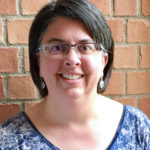 Jeanne Dittmann is a calligrapher and graphic designer who has worked as a freelance artist in Waco for over 14 years. She serves currently as President of the Waco Calligraphy Guild, and she teaches calligraphy through Baylor University Continuing Education. Her day job is the Box Office and Marketing Manager for the Baylor University Theatre. Jeanne and her family attend St. Matthew Lutheran Church, where she and DeAnna Toten Beard started the Fine Arts Ministry 8 years ago. For more information, please contact her at [email protected]
Jeanne Dittmann is a calligrapher and graphic designer who has worked as a freelance artist in Waco for over 14 years. She serves currently as President of the Waco Calligraphy Guild, and she teaches calligraphy through Baylor University Continuing Education. Her day job is the Box Office and Marketing Manager for the Baylor University Theatre. Jeanne and her family attend St. Matthew Lutheran Church, where she and DeAnna Toten Beard started the Fine Arts Ministry 8 years ago. For more information, please contact her at [email protected]
The mission of AVANCE is to unlock America’s potential by strengthening families through effective parent education and support programs. The AVANCE Parent-Child Education Program empowers families to break the cycle of poverty through proven two-generation approach combining parent education and early childhood development. We envision our families as the child’s first teacher, as advocates for their children engaged in their child’s school, and as leaders for their families and their communities. We want to give our families hope for the future. One of my favorite Bible verses is Jeremiah 29:11,” For I know the plans I have for you, declares the Lord, plans for welfare and not for evil, to give you a future and a hope.” Isn’t that what we want for our families and our community?
This past week I was able to involve myself in two new endeavors that I hope will help me be a better advocate and leader for my community and more specifically the AVANCE families I serve. I was accepted for LeadershipPlenty Institute. A training program for people interested in developing and improving their leadership skills to allow them to work more effectively within their communities and the organizations they attend. What a blessing for Waco to have this program! My first thought was this is a great opportunity in which we need to involve our Latino community. It is designed for individuals of various backgrounds, occupations, and experiences. Diversity makes us stronger and together we can achieve more. I hope you take time to explore and consider participating.
My second new experience here in Waco is that I signed up to be a mentor with LEAD. LEAD stands for Leadership, Education, and Development. It is an educational partnership that pairs high school students with business leaders to foster mentoring relationships that educate and expose students to various business fields. It is a truly powerful program sponsored by our local Greater Waco Chamber of Commerce. Having a mentor allows young students to visualize a successful future. It gives them a vision , someone they can identify with. As a Latino Executive Director of a non-profit here in Waco I feel that I can serve as a role model for Latino youth as they navigate their journey to adulthood. It is my way of making a difference. My way of giving hope and a future here in Waco.
 Felipe Benecio Garza graduated from Our Lady of the Lake University with an MSW. He has over 40 years experience working with children and families in various leadership capacities. He is on the Board of Texans Care for Children and the Board of Advocates for the Diana R. Garland School of Social Work. He is Executive Director of AVANCE Waco.
Felipe Benecio Garza graduated from Our Lady of the Lake University with an MSW. He has over 40 years experience working with children and families in various leadership capacities. He is on the Board of Texans Care for Children and the Board of Advocates for the Diana R. Garland School of Social Work. He is Executive Director of AVANCE Waco.
The Act Locally Waco blog publishes posts with a connection to these aspirations for Waco. If you are interested in writing for the Act Locally Waco Blog, please email [email protected] for more information.
By Maegan Bennight
Raising a child in today’s world is tough! Every family has their own challenges they face whether it be financial difficulty, finding the time to get everything done, legal troubles, figuring out what’s for dinner, having that difficult conversation, health problems, our child’s behavioral issues… and sometimes it’s that last option on multiple choice tests, “All of the above.”
Growing up, I often heard the phrase “It takes a village to raise a child”, but it didn’t really hit home for me until recently. Truth be told, I’m a bit of a control freak, and it’s hard for me to ask for help. That wasn’t such a problem when I was a mom to just one child, but since I became a mom of two, even with the help of a super supportive husband, I’ve had to learn that having a village is critical to my family’s success…and my sanity. But what does a village look like? In reality, it has a lot of different faces. For me, it’s the friend that periodically calls or texts reminding me that we need to hang out and that I still haven’t asked her to babysit my kids so I can have time to myself or to have a date night with my husband. It’s my sister that I can call and vent to about anything knowing that she will empathize with me but just might challenge me to rethink my perspective on whatever issue I’m venting about. It’s the app on my phone that gives me a daily Bible verse to help me tend to my spiritual needs and another app that provides me with ideas for activities to engage in with my kids. It’s my daughter’s pre-school teacher that will give me suggestions on how to deal with a particular behavior my daughter is displaying at school. It’s a lady from the local WIC office that happens to engage in a conversation with me at a community event and then ends up helping me trouble shoot ways to get my infant to take a bottle. It’s the mom I met at a Bible study group who friended me on Facebook and suggested I attend an event that connected me to other moms going through a similar season of life. It’s the coworker that gently touches my elbow and asks me how things are going even when she’s dealing with her own struggles. Our villages are all around us. Sometimes our village members are obvious because they’re involved in our day to day lives. Other times they aren’t so obvious for whatever reason, but they are there, waiting for us to recognize and call them to action.
Sometimes we have to be intentional about adding members to our village. MCH Family Outreach offers services to those who are interested in expanding their village. Join us for food, fellowship and fun as we come together to support one another through our parenting journeys.
MCH Caregiver Empowerment Groups
2nd Tuesday of the month
Held at the MCH Family Outreach office, 1111 Herring Avenue, Waco 76708
Next meetings: October 10th & November 14th
Two times to choose from: 11 am-Noon or 6-7 pm
Call 254-750-1263 with any questions
Hope to see you there!

 Maegan Bennight is a case manager in the MCH Family Outreach office providing support to parents, grandparents and other caregivers raising children in and around the Waco community. She is a wife, a mother to a 3 year old daughter and 5 month old son, a graduate of Texas A&M University, and a Central Texas native. You can contact her at [email protected].
Maegan Bennight is a case manager in the MCH Family Outreach office providing support to parents, grandparents and other caregivers raising children in and around the Waco community. She is a wife, a mother to a 3 year old daughter and 5 month old son, a graduate of Texas A&M University, and a Central Texas native. You can contact her at [email protected].
By Lauren Paczynski
I have Generalized Anxiety Disorder, and talking about it is never easy. Not only is it hard to explain anxiety to someone who’s never experienced it, but the nature of the disorder means that I am often nervous about speaking up in the first place. I think it’s important for people struggling with this disorder and others like it to talk about it, though— because if we want our condition to be understood, if we want more and better resources to become available, we first need to create more awareness about what anxiety is, exactly. Having said that, I’d like to share with you five things that I wish people knew about my disorder.
1.”Anxiety” is not just a fancy word for feeling “stressed out.” – Not only do I feel “normal” stress to a greater extent than most, I sometimes feel anxiety that is totally unrelated to anything actually going on in my life. I have whole days where I’m anxious and uncomfortable for no discernible reason, and nothing I do to try to alleviate the feeling seems to work. I often describe it to people this way: it’s like playing a video game or watching a movie and hearing the menacing music that signals something bad is going to happen, except it happens at random times, sometimes constantly. The threat isn’t actually there, but that signal in my brain that something is very wrong (or about to be) won’t go away.
I know I’m being irrational. There’s usually some part of my brain that understands that I’m worrying about something minor. That doesn’t mean that my emotional responses are any less real, or any less scary for me, and that doesn’t mean that telling me I’m overreacting is going to help.
2. Anxiety is “all in my head”— but that’s the problem. I can’t even count the number of times that someone has said some form of this to me— “It’s all in your head, just don’t worry so much!” At this point, I have a hard time responding politely anymore. Telling someone that their anxiety is “all in their head” is about as helpful as telling someone with a broken femur that it’s “all in your leg.” I know that my brain is messed up. That’s the whole problem with mental illness, and implying that because something is psychological it should be easy to fix is frankly a little ignorant. Just like any physical illness, mental illnesses require constant management and care. They can’t be fixed by just wishing them away or ignoring them— believe me, I’ve tried.
3. Anxiety affects everything I do. Not everyone feels this way about their anxiety, but for me it is a core part of who I am. Ultimately it has an effect on everything that I do. Even simple things, like ordering food or answering the phone, get filtered through my anxiety and become ordeals. Speaking up in class gives me a rush of nervous energy. I get nauseous just thinking about giving a presentation. For better or worse, this is my normal, and I live with it daily. As good as I usually am at staying on top of my anxiety, I will always have bad days. It’s on those bad days that the understanding and support of the people around me really makes a difference.
4. It’s not always laziness— sometimes it’s anxiety. Something I didn’t understand about myself for a long time— and something that my parents and teachers have long been frustrated by— is that anxiety can come with additional complications that don’t seem like they’d be related. Anxiety.org elaborates on this, saying “a number of studies have found that high anxiety individuals, such as those with Generalized Anxiety Disorder (GAD), have a decreased ability to ignore irrelevant information, especially when that information is threatening, and greater difficulty switching attention between tasks.”
What this means in practice, at least for me, is that occasionally I have a hard time focusing enough on a task to complete it. I have spent many long evenings at the library staring at an open textbook and trying desperately to make sense of it, or even manage to read it at all. This means that I sometimes have difficulty completing and submitting assignments on time. I had a hard time with this in high school. After years of developing coping strategies and learning how to work around this issue, I am now generally able to do what I need to do even if it’s hard to get started at first, but others may have more difficulty with this than I did.
I’m not arguing that you should ignore your anxious child or student’s failing grades because it isn’t their fault, but I am saying that a little understanding can go a long way. Instead of assuming they’re just lazy, talk to them. Figure out if this is something they might be struggling with, and see about getting them the help they need to overcome it.
5. I can’t “just get over it.” Unlike some physical problems – a broken bone, a fever – an anxiety disorder isn’t something that’s necessarily going to go away. I might be able to control it most or even all of the time, but it’s always going to require time, energy, and effort to do that. When my anxiety is bad, I can’t always just “push through it.” When it is under control it’s still taking up a sizable amount of my energy. That means that I may have to cancel plans sometimes, or miss out on something that I needed or wanted to experience, and that can be frustrating for both myself and the people around me.
If it comes down to a choice between another person’s feelings and my own mental stability, I’m always going to pick myself— I have to. This is something that anyone who loves someone with anxiety, or really with any mental illness, needs to understand. I love my friends, and my family, and my boyfriend, but sometimes self-care and solitude are the only things keeping me afloat. If someone with anxiety cancels on you, try to understand that it’s not that they don’t like spending time with you. It’s just that they may need some time alone to decompress.
Let me be clear that my experiences are not universal. Anxiety comes in many forms and presents itself in a bunch of different, often very personal ways. What I’m talking about here is my anxiety, my experiences. Every individual with anxiety has different needs. If someone you love has anxiety, I encourage you to talk with them about it. Ask them what it’s like for them, and what you can do to help. Not only will it help you understand them, I promise they’ll appreciate the effort.
If you think you or someone you love might be struggling with anxiety, the Anxiety and Depression Association of America has an extensive list of resources for identifying and managing various anxiety disorders: https://adaa.org/living-with-anxiety/ask-and-learn/resources
 This Act Locally Waco Blog post was written by Lauren Paczynski. Lauren is a Senior at Baylor University, studying Professional Writing. A Virginia native, she moved to Texas in 2014 to attend Baylor and intends to stay here (at least for a while). After graduation, she hopes to work in editing & publishing. The Act Locally Waco blog publishes posts with a connection to these aspirations for Waco. If you are interested in writing for the Act Locally Waco Blog, please email [email protected] for more information.
This Act Locally Waco Blog post was written by Lauren Paczynski. Lauren is a Senior at Baylor University, studying Professional Writing. A Virginia native, she moved to Texas in 2014 to attend Baylor and intends to stay here (at least for a while). After graduation, she hopes to work in editing & publishing. The Act Locally Waco blog publishes posts with a connection to these aspirations for Waco. If you are interested in writing for the Act Locally Waco Blog, please email [email protected] for more information.
By Christina Helmick
I recently was at a communications conference in Miami and an attendee asked the speaker, “What are your tips on communicating all the great things happening in your organization and how they all fit into the bigger picture?” I moved to the edge of my seat to be sure I could hear the speaker’s response. The speaker answered with a chuckle followed by what he considered to be a communication rule —“Nonprofits rely heavily on the use of success stories to communicate. Along with the success story, make sure you tie it back into how it fits into the bigger picture. One way I’ve typically tied those two things together with is the use of data.” I thought to myself jackpot!
As the backbone organization of the Prosper Waco initiative, one of our roles is to communicate the successes of the initiative, highlight the partners involved and tie all that back to the big picture through the data that we are tracking. One way the staff pulls all of this together is through an annual report. Around this time each year, the staff produces an annual report that focuses on the progress of the initiative, the efforts within the Prosper Waco umbrella and how organizations and residents can become involved in the initiative.
The 2016-2017 Prosper Waco Initiative Report is ready for distribution! The report is the one-stop-shop for residents, organizations, employers and others to learn about the history of the Prosper Waco initiative, efforts within the Prosper Waco initiative umbrella, initiative goals, key partners and how residents and organizations can become involved in improving overall quality of life in Waco.
For example, on page 12 you will see a graph illustrating the trends in school readiness for Waco ISD pre-kindergarten students. You will notice a decrease in proficiency from Fall 2015 to Fall 2016. The graph also shows the target and overall goal of school readiness—increase the percentage of Kindergarten-ready students (which would be a target goal of 22%).
To the left of the graph of page 13, you will see an explanation of one of the many efforts addressing the School Readiness goal. The effort highlighted is “Reach Out & Read,” a collaborative approach to improving school readiness that utilizes doctors and nurses to help parents understand the importance of reading to their children.
As you peruse the entire report, you will notice the various, cross-sector efforts, led by multiple partners, that are addressing the goals of the initiative. Pages 36 and 37 are an overview of the efforts within the Prosper Waco umbrella and what goal(s) of the initiative each is addressing.
As an organization we try to emphasize there is no silver bullet in alleviating poverty. You may think, “Gee, there is so much going on, why should we keep at it?” Yes, our community is doing amazing work, and we still have work to do. That’s why it is so important to continue the coordinated, cross-sector conversations happening at the Working Groups. Those conversations are helping to align activities to have the biggest impact possible.
It is also important to continue listening to the community’s priorities as in the “What’s Up, Waco?” visioning series, and integrating those priorities into the organization and systems-level conversations happening within the initiative.
And it is important to continue adding new people who are willing to invest in this work, like you. Contact Jillian Jones ([email protected] or call 254-741-0081) to learn how to become involved and to request a digital or physical copy of the 2016-2017 Prosper Waco Initiative Report.
 Christina Helmick is the director of communication at Prosper Waco. She is a recent graduate of Baylor University with a BA in Journalism, Public Relations & New Media. Originally she is from Washington, D.C., but has stayed in Waco post-graduation. She is an active mentor at J.H. Hines Elementary School, enjoys spending time with her family and watching Baylor football. Sic ’em Bears!
Christina Helmick is the director of communication at Prosper Waco. She is a recent graduate of Baylor University with a BA in Journalism, Public Relations & New Media. Originally she is from Washington, D.C., but has stayed in Waco post-graduation. She is an active mentor at J.H. Hines Elementary School, enjoys spending time with her family and watching Baylor football. Sic ’em Bears!
The Act Locally Waco blog publishes posts with a connection to these aspirations for Waco. If you are interested in writing for the Act Locally Waco Blog, please email [email protected] for more information.
By Christine Holecek
The mission of the Heart of Texas P-20 Council is to assist with the collaboration of education, business, and community to maximize the utilization of resources, programs and services for all students while encouraging a culture of life-long learning. We envision that all students can reach their true potential as happy, healthy, productive and self-sufficient citizens. One local event that helps with this mission is S.T.E.A.M. Day.
The City of Waco, along with ESC Region 12, is hosting its annual S.T.E.A.M. Day on October 11. Geared towards middle and high school students in the Central Texas area, this event helps students explore the fields of science, technology, engineering, architecture, arts and mathematics (S.T.E.A.M.). Participating students will be able to speak directly with professionals about career choices in various fields. S.T.E.A.M. Day is a free, come-and-go exhibition for schools and at the Waco Convention Center. The attendance has continued to grow over the past several years. Last year over 2,200 students from 40 schools registered for the event, along with 86 exhibitors from various career fields. Our exhibitor roster included local manufacturing companies, higher education establishments, engineering and architecture firms, and also high school robotics teams. This event is free to exhibitors as well.
This is an awesome event for students to get a hands-on opportunity to see future careers in action. This event has morphed over the years from “Engineering Day” to “STEM Day” and now “STEAM” Day. This event is held annually in October to inspire students to pursue careers in the community in science, technology, engineering, architecture, art and mathematics. This event is hosted by the City of Waco Public Works Department. This year’s event will be held on Tuesday, October 11, 2017 at the Waco Convention Center from 8 a.m. to 2 p.m.

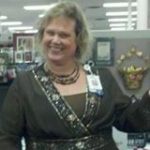 This Act Locally Waco blog post was written by Christine Holecek. Christine is an Education Specialist at Education Service Center Region 12 in Waco. She has worked in the area of Adult Education and Career & Technical Education for the past 25 years. She earned an AAS degree from MCC, a BAAS and Master’s Degree from the University of North Texas and is currently enrolled in the Doctoral Program in Educational Leadership and Policy Studies at Tarleton State University.
This Act Locally Waco blog post was written by Christine Holecek. Christine is an Education Specialist at Education Service Center Region 12 in Waco. She has worked in the area of Adult Education and Career & Technical Education for the past 25 years. She earned an AAS degree from MCC, a BAAS and Master’s Degree from the University of North Texas and is currently enrolled in the Doctoral Program in Educational Leadership and Policy Studies at Tarleton State University.
By Madiha Kark
On a Monday afternoon, about four weeks ago I walked nervously towards the Liberal Arts building at McLennan Community College. It was sometime in 2013 that I had last stepped into a classroom before completing my master’s degree. There were two reasons I was walking into Spanish 1411 that day. First, my lovely husband not so subtly pushed me into it. Second, I wanted to speak to my grandmother-in-law on FaceTime. She is a small (under five feet) adorable lady who speaks Spanish and has a heart the size of Texas.
Full of dread, tired, looking for a single excuse to quit… I walked into that class a little less than excited.
Before I saw Seir Lopez, I heard her. I heard an excited voice “Hola chicos, ¿Como están? ¿Bien? She walked in quickly, but not rushed, a bright full smile on her face, her jet black hair flowing in the air like a well maintained mane. “This is going to be difficult,” I thought.
 Seir has a way of making you interested in a language you’ve never learned. As far back as she can remember, it’s always been like this. She has always loved to teach. When she was child, the importance of education was stressed in her house. She was born in Mexico, but moved to Waco with her family when she was four. Her parents had humble beginnings, they were self-taught and hardworking but didn’t have much education. Being new in the United States they wanted to give their kids the opportunities they didn’t have. One of the rules they had in the house later shaped Seir’s identity. The children could only speak Spanish at home; English was reserved for school.
Seir has a way of making you interested in a language you’ve never learned. As far back as she can remember, it’s always been like this. She has always loved to teach. When she was child, the importance of education was stressed in her house. She was born in Mexico, but moved to Waco with her family when she was four. Her parents had humble beginnings, they were self-taught and hardworking but didn’t have much education. Being new in the United States they wanted to give their kids the opportunities they didn’t have. One of the rules they had in the house later shaped Seir’s identity. The children could only speak Spanish at home; English was reserved for school.
Seir struggled through high school and even thought about dropping out, but her parents were adamant to push her towards higher education. When the time came to choose a college, MCC was always her first choice. It was affordable, had a small community and wasn’t going to be overwhelming. “From the first semester I felt right at home,” she says.
At MCC, Seir had a chance to be on both sides of the desk, as a student and as a teacher. She never felt she had a free pass because it was a community college and the classes were easy. “I have had some of my hardest courses at MCC and I have the utmost respect for the professors.” Even today she remembers the mentors who guided her and credits them for their role in taking her where she is today. She now teaches at Baylor and MCC but doesn’t find any difference in the standards of teaching.
I don’t remember too many details of that first day of class, I just remember what happened after. I went home and my husband, being the supportive man he is, gently and with a hint of guilt said it was ok if I wanted to drop the class. I had had an 8 a.m. – 8p.m. day. What he wasn’t expecting was my answer. “I am not dropping the class, the professor is so much fun,” I said with excitement.
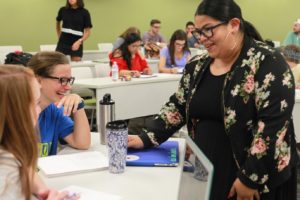 It’s not easy making nearly 30, 20 – 40 year olds excited about learning Spanish. My first impression of Seir was that she was sassy (in a good way) but fun. “I try to integrate my bubbly personality and my passion for teaching Spanish. I take my craft very seriously,” she says. It took her time to develop her teaching style. At first it was too strict or too lenient. After 12 years in the field, she has had time to reflect and tweak her methods. “It comes from experience,” she says humbly.
It’s not easy making nearly 30, 20 – 40 year olds excited about learning Spanish. My first impression of Seir was that she was sassy (in a good way) but fun. “I try to integrate my bubbly personality and my passion for teaching Spanish. I take my craft very seriously,” she says. It took her time to develop her teaching style. At first it was too strict or too lenient. After 12 years in the field, she has had time to reflect and tweak her methods. “It comes from experience,” she says humbly.
Behind all that experience is a lot of hard work and persistence, traits that were instilled in her from a very early age. Seir was the first in her family to go college. She ate self-motivation for breakfast and spent the last year of her high school constantly outside her advisor’s office. “I couldn’t ask my parents for help with SATs or scholarship applications, I had to do that myself.”
She was a pre-med major at MCC. She wanted to be a doctor because she wanted to make more money. “When you are young you don’t realize what you love, you just think about what would make money.” A Spanish class at Baylor helped her find her true passion. She got a zero on the first assignment in that class and it lit a fire under her. Seir was determined to prove to the professor that she was better than that. She promised herself to never get a zero again. She succeeded. It was a turning point in her life. “It was tied so closely to my roots, my identity and who I am, a Hispanic woman.”
If someone says she can’t do it, “It lights a fire under me and I rise to the occasion. I’ve always been a leader type figure.”
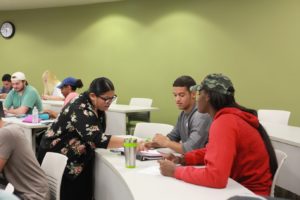 For Seir, Spanish is not just her language, it’s at the core of her identity and who she is. She thanks her parents for insisting on their rule of speaking Spanish in the house. It helped her form her own identity while being a part of American culture. Their mantra was “know who you are and where you come from.”
For Seir, Spanish is not just her language, it’s at the core of her identity and who she is. She thanks her parents for insisting on their rule of speaking Spanish in the house. It helped her form her own identity while being a part of American culture. Their mantra was “know who you are and where you come from.”
I am still taking her class, and this article doesn’t mean I get preferential treatment or a pass on an assignment! It has given me an opportunity to know a Seir a little more personally and for that I am grateful. Gracias maestra!
 Madiha Kark is a Marketing, Communications and Photography Specialist at McLennan Community College. She holds an M.A. in Journalism from the University of North Texas. She loves to travel, cook, and read nonfiction books.
Madiha Kark is a Marketing, Communications and Photography Specialist at McLennan Community College. She holds an M.A. in Journalism from the University of North Texas. She loves to travel, cook, and read nonfiction books.
The Act Locally Waco blog publishes posts with a connection to these aspirations for Waco. If you are interested in writing for the Act Locally Waco Blog, please email [email protected] for more information.
By Rolando Rodriguez
Pumpkin spice lattes and Halloween decorations aren’t the only things back this fall season. The 2018-2019 FAFSA (Free Application for Federal Student Aid) is NOW available.
FAFSA is a federal application for ALL current and prospective college students that is used to determine how much a student is eligible to receive in need-based financial aid, such as the free Pell Grant. The FAFSA is used to collect information about a student’s family income and other household information. This information is used to determine a student’s expected family contribution (EFC). The EFC number that is generated is used to determine how much financial aid for college the student is eligible to receive.
FAFSA is more than just an application for Pell Grant. It is also used to determine loan eligibility as well as eligibility for need-based scholarships and state grants.
Many separate scholarship applications, especially those with a financial need component, will ask for information from your FAFSA. Essentially, FAFSA is one application that opens multiple financial aid avenues.
To help guide you through the financial aid process, below are 10 tips you should consider before starting your FAFSA.
1. FAFSA doesn’t actually start with FAFSA. – FAFSA begins with creating a Federal Student Aid ID (FSA ID) for both the student and the parent at fsaid.ed.gov. The FSA ID is essentially a username and password that the student and parent will use to log in to the FAFSA and sign the FAFSA electronically.
You will need unique email addresses for the student and parent, since your FSA ID is attached to your social security number.
If a parent already has an FSA ID from when they were in college or from an older student that has previously started college, then that parent will continue using the same FSA ID.
2. Go to the correct website. – Be sure to go to the correct website for FAFSA—fafsa.ed.gov. Some sites that are similar to the official, government FAFSA website, will ask the student to pay a fee in order to submit the application. You should NEVER have to pay for FAFSA. It is in the acronym—FREE Application for Federal Student Aid.
3.Use the IRS Data Retrieval Tool. – FAFSA will ask for both parent and student tax information, specifically the 2016 tax return.
Consider the IRS Data Retrieval Tool (IRS DRT) on the FAFSA your own personal, virtual tax accountant. The IRS DRT takes all of the hard work out of your FAFSA by directly importing your tax information from the IRS into your FAFSA.
4. Correctly define your dependency status. – In addition to financial information, FAFSA will also ask about household information, starting with determining the student’s dependency status. Most students will be using their parents’ tax information, but there are a few situations that can classify a student as independent. In the cases where a student is considered independent, the student does not need to report any parent information.
Please review the dependency flowchart below provided by the Federal Student Aid Office:

5. List multiple schools on your FAFSA. – If you’re not quite sure what school you want to attend yet, you can list up to 10 schools on your FAFSA. You could potentially receive an award package from each college listed, and you can compare which college offers you the more advantageous financial aid package. However, you will only receive financial aid packages from the colleges to which you were accepted for admissions.
6. Correctly report your financial information. – Unfortunately, the IRS DRT does not answer every financial question for you. One of the more complex questions on FAFSA is regarding assets. Since parents are seen as having more financial responsibilities than a student, their assets won’t impact a student’s financial aid eligibility as much.
However, for a student, any funds in their checking or savings account will be considered funding for college. Federal Student Aid will assume you do not need as much financial aid if you have a large sum generally over $500. Contact the MAC College Money Program for more information about reporting assets. Please contact Rolando Rodriguez by email at [email protected] or phone at 254.752.9457. Office hours are Monday-Friday from 9:00 a.m. to 5:00 p.m.
7. FAFSA doesn’t actually end when you click submit. – After you click submit on your FAFSA, you will receive your confirmation page with your Pell Grant eligibility. Do not assume you are finished with the financial aid process.
Some students are randomly selected for a process called verification, which means the college needs to confirm the financial and household information you submitted in your FAFSA. The college will inform you via email if you need to submit additional paperwork.
Using the IRS DRT reduces your chances of being selected for verification because it is a more official and secure process coming directly from the IRS, so be sure to use the tool if it is available to you.
8. Everyone has to submit FAFSA. – Every student who will be attending college should submit a FAFSA even if he or she is not expecting to receive any need-based financial aid, such as the Pell Grant. Most colleges will not award the student any loans, academic scholarships or even athletic scholarships until the FAFSA is on file.
9. Don’t wait until the last minute. – Do not wait until the last minute to submit your FAFSA or to go through the verification process because financial aid offices tend to be at their busiest right before the beginning of the school year. Don’t be the person waiting on hold on the phone for an hour. It’s best to have your FAFSA submitted by December 1st to provide enough time to go through an additional processes, such as verification or comparing different award packages.
 10. The MAC Program is your resource. – The goal of Waco Foundation’s MAC College Money Program is to make the financial aid process as easy as possible whether you are a high school senior starting college next year, a returning student or going back after a break. We are available to offer you personalized assistance in submitting the FAFSA and completing the financial aid process.
10. The MAC Program is your resource. – The goal of Waco Foundation’s MAC College Money Program is to make the financial aid process as easy as possible whether you are a high school senior starting college next year, a returning student or going back after a break. We are available to offer you personalized assistance in submitting the FAFSA and completing the financial aid process.
If you need assistance with submitting your FAFSA, please contact the MAC Program at 254.752.9457 or by email ([email protected]) to set up an appointment at our office. A highly trained FAFSA expert will be available to walk you through the financial aid process. Our services are FREE to anyone!
MAC Grant
In addition to one-on-one FAFSA assistance, the MAC Program also offers the need-based MAC Grant to McLennan County students. The Grant is up to $1,000 per semester for two years at either MCC or TSTC to cover the gap between financial aid received and the cost of tuition.
Students must apply by May 1st of their senior year. The application can be found on our website.
MAC Scholarship
The MAC Program also offers a third and fourth year MAC Scholarship to those students who were accepted into the MAC Program as seniors in high school even if the student did not start at MCC or TSTC or use the MAC Grant.
The scholarship is a total of $5,000 to be used for the student’s third and fourth year of college, and the scholarship can be used at any institution.
MAC Grant recipients should apply for the scholarship by December 1st of their college sophomore year, and they should have a 3.0 GPA and 60 credit hours by the end of their college sophomore year. The application can be found on our website.
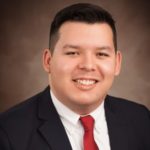 Rolando Rodriguez was raised in Waco, TX, and he graduated with honors from Baylor University with a bachelor of arts in professional writing & rhetoric. He has recently joined Waco Foundation as the MAC & Scholarship Coordinator as an advocate of higher education for all students in McLennan County regardless of financial circumstance. His role with the Foundation is to help McLennan County students with the financial aid process for college.
Rolando Rodriguez was raised in Waco, TX, and he graduated with honors from Baylor University with a bachelor of arts in professional writing & rhetoric. He has recently joined Waco Foundation as the MAC & Scholarship Coordinator as an advocate of higher education for all students in McLennan County regardless of financial circumstance. His role with the Foundation is to help McLennan County students with the financial aid process for college.
(Tami Nutall Jefferson, a married mother and grandmother, is going back to school and she has invited us all along to enjoy the ride. For more posts in this series, click here: Tami’s Big Do Over. – ABT )
By Tami Nutall Jefferson
The Truth About Age
If your life were a road trip, age would be your mile marker. Its sole purpose is to frame your goal-setting for every 12-month period so you can look back and see the tangible progress you have made – or not – towards your destination. This is easy enough when you’re in primary and secondary school – you have plenty of people setting goals for you and driving you towards them – even when all you want to do is play. But when you become college age – years 18 to…say, death – that goal setting and driving is now up to you. And it’s up to you to say when playtime is over.
I woke up the other morning and the first thing my God said to me was “Make current decisions based on your future self and one day you will meet your future self.” I wish I had known this principle at mile marker 15; but I get it today at mile marker 42. You know who else got it at mile marker 44 (same mile I’ll be at when I graduate)? Sam Walton! Sam Walton started his first five-and-dime Walton store at age 44. Who cares what he did the first 44 miles, he slayed those last 30 – for himself his family and the world.
A Collective Journey
Every graduation season, we see news stories and social media posts celebrating a new “twilight-years” graduate. An awesome thing, but my question is always “What was their journey like before graduation day? What’s their real story?” I wanted to do this column to seek out and share those answers with people who care and need such inspiration. So this month, it is my pleasure to introduce my new friend, and Wacoan, Meg Wallace, and her mile marker 52 college journey.
All About Meg
TNJ > Hello friend. Introduce yourself to us – your collegiate status, what matters most to you.
MW > Hi. I’m Meg Wallace, and I’m graduating from Baylor in May 2018 with a Master’s in Social Work. I’m also an empty nester, and I miss my two daughters something awful, but parenting by telephone has a certain kind of loveliness. I treasure the long, thoughtful conversations that we might not have had so regularly otherwise.
TNJ > What’s your Waco story?
MW > My husband, Robin, and I wrangled a U-Haul clear from Chicago to Waco in August 2016 after helping my younger daughter pack up for college. I had married Robin, a Baylor musicology professor and father of two fine young adults, in January 2014, but we maintained two households until I got my girls launched. Fortunately, Robin was able to take a sabbatical and spend a year in Chicago while he wrote his forthcoming book, before we finally made our home together here in Waco.
TNJ > Why college? Why now at this mile marker in your life?
MW > Once my girls were launched, it was finally time for to relaunch myself. I have a BSW and started my career in community work back in the ‘80s; freelancing for academic publishers while raising my girls. I’ve been itching for a career change for ages, but going back to school would have been impossible for me while I was supporting my family and raising my children. Some Baylor MSW students are doing it all at the same time. They are my heroes!
TNJ > What’s your next big step after graduating from Baylor?
MW > I wish I knew what will happen after school! My professional goal is to help congregations care well for their members because I know how important people’s natural support systems are when they’re walking through challenges. But not many places hire for that sort of work. Finding out what’s next will be an adventure.
TNJ > What is the college environment like for you at this stage in your life?
MW > Most of my classmates are very close in age to Robin’s and my kids, so I’m learning with people who could be my kids’ peers. It works out because I enjoy my kids and their friends, and they teach me a lot, just as my classmates do now. The greatest compliment I’ve received was when I heard through the grapevine that some of my classmates were talking about how they would love to have a mom like me. I’m not sure what my kids would think about that, but I sure appreciated the sentiment.
TNJ > What does your college and life experience look like today?
MW > Between putting in 16 to 20 hours a week at internship, working part-time, and taking 14 credit hours of classes, it’s impossible for me to spend as much time with my husband and children we would like. But they’re all on board with my relaunch, and I’m so grateful for their support. The light is at the end of the tunnel!
TNJ > What would you say to colleges & universities on behalf of their non-traditional students?
MW > Diversity in higher education requires making the college or grad school experience feasible so students can see it through. If professional schools that require internships want to attract and hang on to students of varying ages, nationalities, income levels, ethnic and racial backgrounds, and abilities who have varying earning needs, home responsibilities, and previous school experience, they need to think seriously about how to make diversity doable. Maybe they could revise coursework to eliminate redundancy, for example, and allow more ways for internship, class obligations, and income earning to align with each other. Nontraditional students are veteran jugglers. We have a lot to offer decision makers who are looking for new ways to make diversity doable while juggling their own many obligations.
Thank you, Meg for sharing your journey. Kudos and welcome to the new Waco!
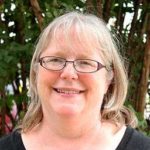 Meg Wallace is a Community Wellness Intern at Waco Regional Baptist Association and can be reached at [email protected]
Meg Wallace is a Community Wellness Intern at Waco Regional Baptist Association and can be reached at [email protected]
 Tami Nutall Jefferson is an older, non-traditional student with a professional real estate background. Tami begins her first academic year at Texas A&M University pursuing a Bachelor’s Degree in Urban Planning and Real Estate Development while commuting between Waco and College Station. Her hope is that Waco becomes the most attractive, modern, vibrant, and prosperous version of itself as an inclusive city and her professional mission is to help make that happen as a real estate developer and entrepreneur. Tami volunteers her time and voice to many downtown Waco placemaking and economic development causes and organizations.
Tami Nutall Jefferson is an older, non-traditional student with a professional real estate background. Tami begins her first academic year at Texas A&M University pursuing a Bachelor’s Degree in Urban Planning and Real Estate Development while commuting between Waco and College Station. Her hope is that Waco becomes the most attractive, modern, vibrant, and prosperous version of itself as an inclusive city and her professional mission is to help make that happen as a real estate developer and entrepreneur. Tami volunteers her time and voice to many downtown Waco placemaking and economic development causes and organizations.
To engage and share your non-traditional student experiences with Tami, contact her at [email protected] or connect with her on Facebook https://m.facebook.com/tami.nutall1
